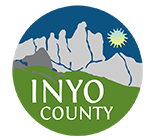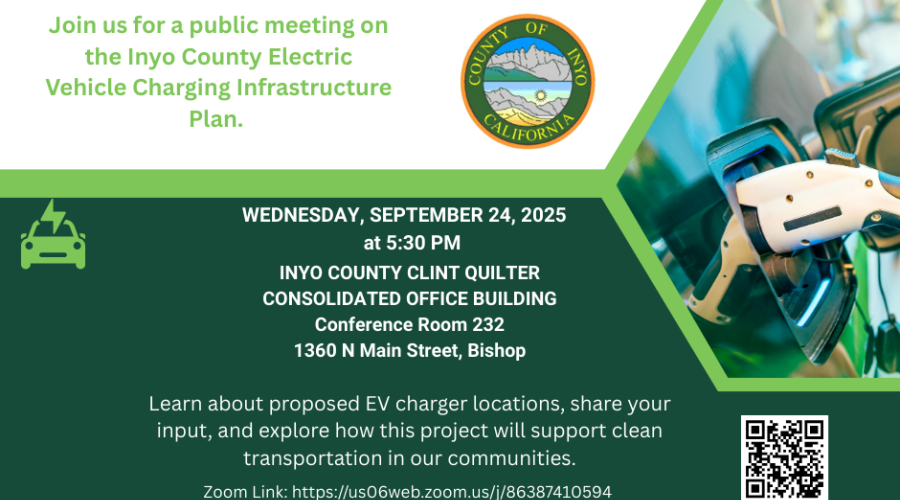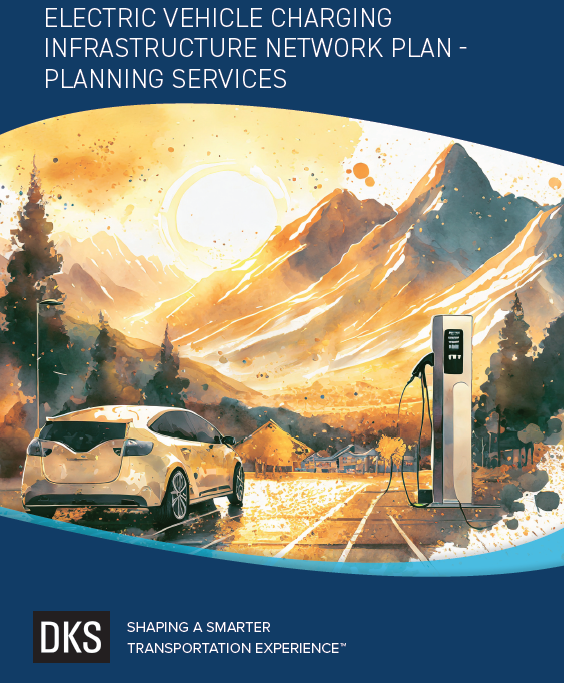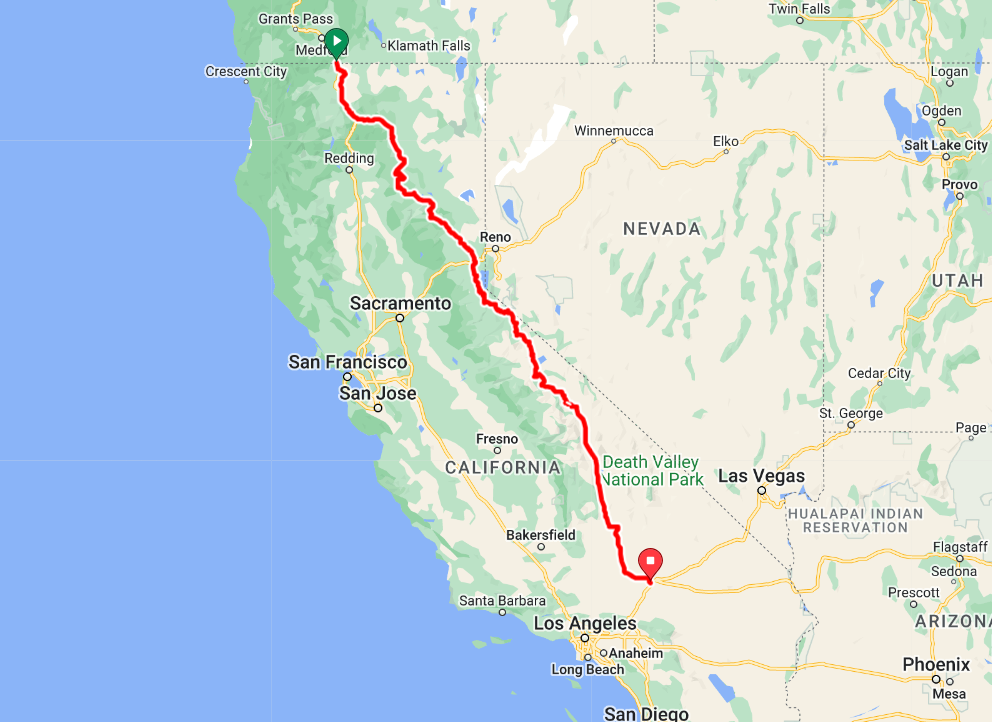Inyo County Local Transportation Commission
The Inyo County Local Transportation Commission (ICLTC) is a six-member commission that serves as the State mandated Regional Transportation Planning Agency (RTPA) for Inyo County. Representation on the ICLTC consists of two members each from the Inyo County Board of Supervisors and the Bishop City Council, while the remaining two seats are Board and Council appointed at-large representatives. The Inyo County Public Works Director serves as the Executive Director of the ICLTC. Follow the corresponding link to view the ICLTC By-Laws and Organization and Procedures Manual.
The ICLTC prepares an annual Overall Work Program and a Regional Transportation Plan every four years, as well as programming projects into transportation improvement programs. The ICLTC also administers Transportation Development Act (TDA) funds and prioritizes grant funding endorsements from a variety of programs. The TDA involves two major funding sources: the Local Transportation Fund (LTF) and the State Transit Assistance Fund (STA). TDA funds can be used by the City of Bishop and the County of Inyo for transportation planning, expenses related to administering the TDA, pedestrian and bicycle facilities, the transit system, and/or for street and road projects. STA funding is allocated to transit operators and is a second source of TDA funding for transportation planning and mass transportation purposes. The ICLTC convenes noticed public hearings on the third Wednesday of every month to address transportation issues.
MEMBERS OF THE LOCAL TRANSPORTATION COMMISSION:
Voting Members
- Celeste Berg - City of Bishop, Member At-Large (Chair)
- Jose Garcia - City of Bishop, Council Member
- Scott Marcellin - County of Inyo, Board of Supervisors Member
- Stephen Muchovej- City of Bishop, Council Member
- Jeffery Ray - County of Inyo, Member At-Large (Vice Chair)
- Jennifer Roeser - County of Inyo, Board of Supervisors Member
Alternate Members
- Will Wadelton - County of Inyo, Alternate Board of Supervisors Member
- Karen Kong - City of Bishop, Alternate Council Member
Non-Voting Members
- Michael Errante - Executive Director
- Amy Cutright - Commission Secretary
Inyo County LTC works in cooperation with various state agencies and other planning organizations throughout the state to ensure a coordinated approach to transportation planning. Inyo County LTC is a member of the Eastern California Transportation Planning Partnership. The Eastern California Transportation Planning Partnership comprises representatives from Inyo, Kern, Mono and San Bernardino counties, and Caltrans. It is intended to address transportation corridors of mutual concern, such as State Routes 14, 58 and U.S. 395. Route improvements in eastern California will ensure that vital tourism, public transportation and freight movement interests among all regions are properly addressed over the next several decades.
If you have any questions, comments, or other feedback, please call (760) 878-0202 or send LTC staff an e-mail message.
Inyo County LTC
168 N. Edwards St.
Independence, CA93526
United States
P.O. Drawer Q
Independence, CA93526
United States
The Overall Work Program (OWP) serves as a roadmap or primary management tool for the Inyo County Local Transportation Commission. Each year the Inyo County Local Transportation Commission is required to adopt an OWP concurrent with the fiscal year. An OWP is described on page 2-1 of the California Department of Transportation Regional Planning Handbook as follows:
The OWP introduces the agency and provides an overview of the region, with a focus on its transportation goals and objectives, and the actions to achieve those goals and objectives. The OWP is a scope of work for transportation planning activities, including estimated costs, funding sources, and completion schedules.
The Regional Planning Agency 2017 Regional Transportation Planning Agency Handbook sets forth the criteria that the OWP must comply with. The Regional Planning Handbook serves as a guide to administering Overall Work Programs, Regional Transportation Plans and their funding sources. The Regional Planning Handbook characterizes the OWP as follows:
The core regional transportation planning document is the Overall Work Program (OWP) and its core product is the Regional Transportation Plan (RTP).
The OWP and RTP are directly and inextricably interconnected. OWP activities support the RTP and development of the RTP is an OWP activity. The RTP is implemented through the Regional Transportation Improvement Program (RTIP) and the Federal Transportation Improvement Program (FTIP). Development of the RTIP and FTIP are OWP activities.
The Regional Transportation Plan (RTP) serves as the planning blueprint to guide transportation investments in the County involving local, state, and federal funding over the next twenty years. Transportation improvements are categorized as short-term (0-10 years) or long-term (11-20 years). The overall focus of the RTP is directed at developing a coordinated and balanced multi-modal regional transportation system that is financially constrained to the revenues anticipated over the life of the plan. The coordination focus brings the County, City of Bishop, Indian Tribal Governments, resource agencies, and citizens into the planning process. The balance is achieved by considering investment and improvements for moving people and goods across all modes including roads, transit, bicycle, pedestrian, goods, and aviation. Individual projects identified in the Regional Transportation Plan will receive further project-specific environmental review. Comprehensive updates to the RTP are supposed to be completed every 5 years. In 2014, the Inyo County LTC elected to update the RTP every 4 years after the completion of the 2015 update. As a result of this change, Inyo County and the City of Bishop are now only required to update the Housing Elements of their General Plans every 8 years.
Amendment No. 1 - the Inyo County LTC has prepared and amendment to the Regional Transportation Plan to ensure compatibility with the 2025 RTIP. The amendment will be considered for adoption after a public hearing to be held during the January 21, 2026 LTC meeting. Public Comment on the amended RTP was open from 11/19/2025 until 01/21/2026.
Feel free to call 760-878-0201 or e-mail with questions or comments.
The Inyo County LTC is responsible for the preparation of the Regional Transportation Improvement Program (RTIP), in collaboration with Caltrans, and submitted for adoption by the California Transportation Commission (CTC). Inyo County LTC submits its RTIP to the CTC for potential inclusion in the State Transportation Improvement Program (STIP). The RTIP, at its core, specifies project cost amounts by project components and the fiscal year in which funds are available.
The STIP is a biennial document adopted no later than April 1 of each even numbered year. Each STIP will cover a five year period and add two new years of programming capacity. Each new STIP will include projects carried forward from the previous STIP plus new projects and reserves from among those proposed by regional agencies in their RTIPs and by Caltrans in its interregional transportation improvement program (ITIP). The Caltrans Division of Local Assistance provides guidelines for local agencies to deliver projects included in the STIP.
The STIP consists of two broad programs, the regional program funded from 75% of new STIP funding and the interregional program funded from 25% of new STIP funding. The 75% regional program is further subdivided by formula into county shares. County shares are available solely for projects nominated by regions in their RTIPs. The Caltrans ITIP will nominate only projects for the interregional program.
The current structure of the STIP was initiated by SB 45 in 1997. The STIP is constrained by the amount of funds estimated to be available for the STIP period in the fund estimate, which is developed by Caltrans and adopted by the Commission every other odd year. The amount available for the STIP is then constrained by formulas for regional and interregional shares per Streets and Highways Code.
Inyo County LTC RTIP
The Inyo County LTC approved its 2025 RTIP following a public hearing on November 19, 2025. The funding for the STIP is relatively stable because of SB 1. Effective 2019-20, SB 1 resets the price based excise tax to 17.3 cents with the provision to adjust it annually for inflation. This has helped to stabilize the funding for the State Highway Account that is directed to fund the STIP. The 2026 STIP Guidelines and the Fund Estimate can be viewed by following the corresponding links.
MOU’s on the State Highway - The Inyo County Local Transportation Commission (LTC) entered into MOUs in 1998 and 2001 for several projects on the US Highway 395/State Route 14 Corridor. The signatories to this MOU were the Inyo County LTC, Mono County LTC, and Kern Council of Governments (Kern COG). These agencies jointly committed to use Regional Improvement Program (RIP) shares programmed in each agency’s RTIP. The purpose of the MOUs was to move forward regionally significant projects that leveraged state controlled Interregional Improvement Program funding to be used in the US 395/SR 14 corridor. The MOU partnership resulted in significant improvements to safety for interregional and local users of the corridor. The final MOU partnership terminated during the 2022 STIP cycle.
ITIP - The 2026 Draft Interregional Transportation Improvement Program (ITIP) has been released by Caltrans and will be incorporated into the 2024 STIP by the CTC on March 21-22, 2024. The 2024 ITIP includes safety improvements to the Freeman Gulch project in Kern County.

The Inyo County LTC maintains a Pavement Management Program for Inyo County and the City of Bishop. The system utilizes software that synthesizes pavement condition index (PCI) data for roads and assigns a score of 0-100. A score of 70-100 is good to excellent, 50-69 is at risk, 25-49 is poor, and 0-24 is failed. Each roadway is assessed every three years.
The PCI data is utilized by County and City staff to prioritize and determine the need for preservation and repairs. The eventual goal of the program is to attain good to excellent pavement conditions allowing for best management practices that preclude the need for expensive deferred maintenance. Reconstruction of failed roadways can cost up to five times higher than conducting routine preventative maintenance every five to seven years. Maintaining pavement in good condition is in the best interest of the tax payers, traveling public and for the environment.
As the administrator of Transportation Development Act (TDA) funds for Inyo County, the Inyo County Local Transportation Commission (LTC) is charged with performing the annual Unmet Transit Needs process. The purpose of this process is to ensure that all unmet transit needs that are reasonable to meet are met before funds are expended for non-transit uses, such as streets and roads. The Social Services Transportation Advisory Council (SSTAC) kicked off the annual Unmet Transit Needs process at an on-line meeting on February 9, 2022. The SSTAC meeting is the first step in deciding disbursement of the Transportation Development Act funds. Additional public input is sought at the Unmet Transit Needs hearings. Results and ideas from the SSTAC meeting and hearings will presented to the Inyo County LTC.
The Inyo County LTC has not allocated TDA funds to the County and the City for local streets and roads for at least twelve years. TDA revenues have leveled out the past few years. ESTA has been able to fine tune their system to address some of the identified transit needs in the last several years. Additionally ESTA has been able to successfully apply for grants to supply transit service for needs raised at the unmet transit needs hearing process. The LTC still holds an unmet transit needs workshops and a hearing to gauge the health of the transit system and to further refine the use of transit funds. Public input from transit users and the transit-dependent is an effective way to identify changing transit needs.
It is helpful to review the definitions of “Unmet Transit Need” and “Reasonable to Meet”. These definitions serve as barometers of the need for new or changed transit services.
An Unmet Transit Need exists if an individual or individuals of any age or physical condition are unable to transport themselves from one location to another. An Unmet Transit Need is, at a minimum, those public transportation or specialized transportation services that are identified in the Regional Transportation Plan and that have not been implemented or funded.
A documented Unmet Transit Need is reasonable to meet if:
A service can be provided which meets a minimum farebox ratio of 10% of operating costs; and
a) It is transit service for essential intra-county purposes which are defined as medical or dental services, shopping, employment, personal business, or social service appointments; or,
b) It is a transit service for essential inter-county purposes which are defined as medical or dental services or social service appointments not available in this county or the out-of-county destination is the closest location where the services are available to the origin of the trip; and, The origin and/or designation of the trip is within two miles of the established area of operation of cohesive community.
On July 1st, 2007, Inyo Mono Transit officially became the Eastern Sierra Transit Authority (ESTA). ESTA offers affordable transportation throughout Inyo and Mono Counties. ESTA operates door-to-door bus service in the communities of Bishop, Mammoth Lakes, Lone Pine, and Walker, as well as operating the Eastern Sierra’s only interregional routes between Reno and Lancaster. The northbound 395 Route service accesses the Reno-Tahoe International Airport and the Centennial Transit Center in Sparks, NV which connects to Greyhound and Nevada RTC buses. The southbound 395 Route service accesses the MetroLink and Greyhound stations in Lancaster. ESTA offers service between Lone Pine and Bishop and between Bishop and Mammoth Lakes. The ESTA website can be viewed online by the link above. Their Annual Report can be viewed on their website. You can also view the most recent Triennial Performance Audit of ESTA and the Transit Authority Joint Powers Agreement that created ESTA can be viewed ESTA's Financial Plans and Resources page.
All County maintained streets and roads (paved or dirt) are considered to be ‘highways’ under the California Vehicle Code. Currently, the combined-use of County maintained roads by OHV is only allowed on the seven approved combined-use routes described below. The project proponents who proposed these combined-use routes refer to the routes as "Adventure Trails."
Background: At a public hearing on January 22, 2015 the Board of Supervisors approved 7 combined-use routes. On July 14, 2015, the Independence No. 1 combined use route was opened for combined use by qualifying OHVs. On July 24, 2015, the Lone Pine No. 1 combined use route also opened for qualifying vehicles. Bishop Routes No. 5, 6, 7, 9 & 15 were opened for combined use between August 5, 2015 and September 5, 2017. Maps showing those routes can be viewed by following the corresponding links. Each map shows the conditions placed on each user of the combined-use routes.
Public Comments: The concerned public can comment via e-mail on any issues surrounding the designated combined-use routes at ab628. Section 14(f) of the Inyo County Implementing Procedures state that:
The Public Works Department shall maintain a website that is a central hub for collecting public and public agency comments and complaints on the combined-use routes which shall include all correspondence from the public and public agencies regarding all combined use segments.
This website serves this purpose and is a central hub for receiving comments. The public may make comments at the following address: ab628@inyocounty.us
Reporting: On December 8, 2015 the Inyo County Board of Supervisors provided initial feedback on a report to the Californa Legislature. The staff report includes a traffic count completed for two locations along each combined-use route. The Board approved submittal of the Legislative Report at a public hearing at December 15, 2015. There were minor changes made to the draft report in response to public comments at the meeting on December 8. The draft report to the Legislature can be viewed on pages 139-186 of the Board Agenda packet pdf document. The Final Report (4,765 KB) was forwarded to the California Legislature.
On December 11, 2018 the Inyo County Board of Supervisors held a public hearing and approved a Report to the Legislature, as required, on the status of the Adventure Trails Combined Use Program. The Final Status Report was submitted on December 20, 2018. The authorization of the program will sunset on January 1, 2025 unless the Legislature extends the program, or passes permanent legislation.
Pursuant to Vehicle Code section 38026.1(f), Inyo County submitted a report to the Legislature on December 29, 2021 in consultation with the Department of Fish and Wildlife and the Great Basin Unified Air Pollution Control District detailing the operation and impacts of the pilot trail system, including impacts on the neighboring lands, cultural resources and archeological sites, streambed modifications and water quality, protections for wildlife and aquatic habitat, native plants, traffic, particulate pollution, and noise. It was amended on March 18, 2022 to include "A Citizens' Full Report "Off-Highway Vehicle Impacts in Inyo County, CA"" The amended Legislative report is here.
On December 12, 2023, the Inyo County Board of Supervisors held a public hearing and approved the 2024 Report to the Legislature. Following public comment, the Board made the decision to not pursue an extension to the pilot program, allowing it to sunset on January 1, 2025.
Assembly Bill 628, Senate Bill 1345, and Senate Bill 402 made revisions to the California Vehicle Code establishing a pilot project allowing Inyo County to designate specific County highways (streets and roads) as combined-use routes. The future designation of combined use routes would allow the use of County streets and roads by Off-Highway Vehicle (OHV). On May 8, 2012, the Board of Supervisors adopted implementing procedures for the designation of combined-use routes.
Assembly Bill 628, Senate Bill 1345, and SB 402 authorize the County of Inyo to establish a pilot project to designate combined-use highways on unincorporated county roads for no more than 10 miles. The combined-use highways can be used to link existing off-highway motor vehicle trails and trailheads on federal Bureau of Land Management (BLM) or United States Forest Service lands in order to provide a unified linkage of trail systems for off-highway motor vehicles. Other goals for the project are to preserve traffic safety, improve natural resource protection, reduce off-highway vehicle trespass on private land, and minimize impacts on county residents. The provisions of SB 402 sunset January 1, 2025. The County is required to submit a report for SB 402 to the Califoria Legislature before January 1, 2019, January 1, 2022, and January 1, 2024.
OHV users on all combined-use routes must:
- Drivers must have in possession a valid driver’s license of the appropriate class for the vehicle being operated.
- Ride during daylight hours only and not earlier that 7:00 am and no later than 8:00 pm.
- Have an operational stop light.
- Have insurance in accordance with the provisions of article 2 (commencing with Section 1160230) of Chapter 1 of Division 7 of the California Vehicle Code.
- Obey the posted speed limit for OHVs on combined-use roads and, in residential areas, drive no faster than 15 mph.
- Use a vehicle that has rubber tires.
- Pass at least three (3) feet away from bicyclists, horses, and pedestrians.
- Slow to 5 mph when passing horses or pedestrians.
- Ride only on existing trails.
- Not stop in flowing water.
- Drive in the middle of the vehicle lane.
- Not drive on the shoulder.
- Use existing trails when exiting a combined-use route.
- OHV operators must operate the OHV in accordance with the vehicle manufacturer’s recommendation for use of the vehicle
Environmental Review: Inyo County released a Draft Environmental Impact Report for the consideration of a proposed system of combined-use roads known collectively as the Adventure Trails System of the Eastern Sierra. Scoping meetings were held in late October 2013 in Independence and Bishop. The public comment period ran from July 17, 2014 to September 2, 2014.
A Final Environmental Impact Report was released on October 29, 2014. The Inyo County Planning Commission made a recommendation to the Board of Supervisors 1) to certify the FEIR, 2) to provide direction to staff on which combined-use routes to recommend to the Board, and 3) to revise the Implementing Procedures at a special November 5, 2014 meeting at 5:00 p.m. in Independence. The Board of Supervisors considered the project at a special 10:00 a.m. January 22, 2015 meeting in Independence. At the January 22nd meeting, the Board of Supervisors approved 7 routes and deferred consideration of other routes. The Board also amended the Implementing Procedures.
FY 2016-2017 State Parks Grant: The Inyo County Board of Supervisors approved submittal of a grant to the California State Parks Off Highway Motor Vehicle Recreation Division on February 21, 2017. The County requested funds for the completion of a National Environmental Policy Act (NEPA) document evaluating potential environmental impacts resulting from jurisdictional agreement(s) between Inyo County and the Inyo National Forest for those County roads part of the Inyo County Maintained Mileage System that cross Inyo National Forest land and are proposed for combined use. The County was subsequently awarded the grant.
For any other questions regarding the combined-use routes in Inyo County, please e-mail Inyo County staff.
News Items: Inyo County Local Transportation Commission
Inyo County Local Transportation Commission Documents
Inyo County LTC
168 N. Edwards St.
Independence, CA93526
United States
P.O. Drawer Q
Independence, CA93526
United States



